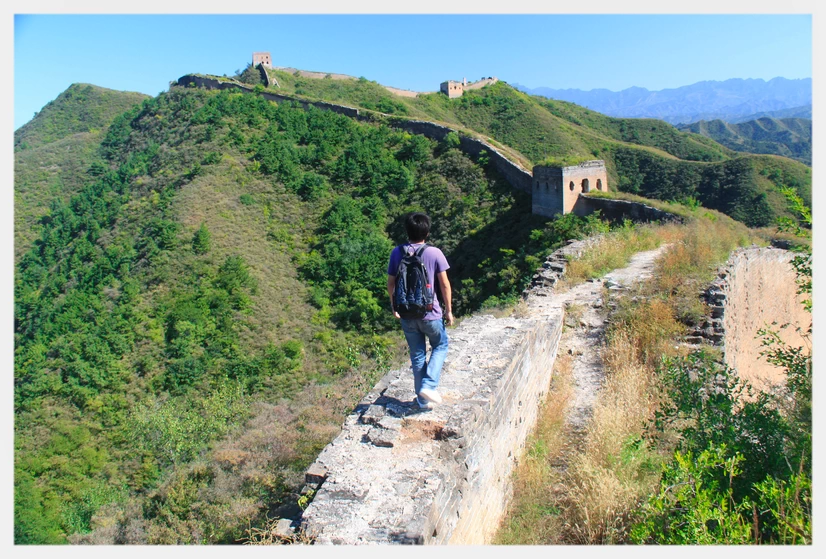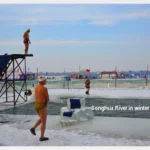Beijing, the capital city of China, is home to numerous iconic buildings that symbolize the country’s history, culture, and architectural achievements. Here is a list of some of the top iconic buildings in Beijing:
The Great Wall of China
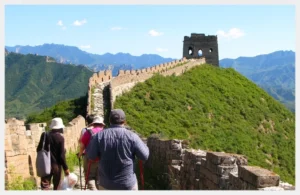
Although not located within the city limits, the Great Wall is one of China’s most famous landmarks and a UNESCO World Heritage Site. Several sections of the Great Wall, such as Badaling and Mutianyu, are easily accessible from Beijing.
The Great Wall of China runs across the northern part of China, spanning from the east coast to the west. It stretches over various provinces and regions, including Hebei, Beijing, Tianjin, Shanxi, Shaanxi, Inner Mongolia, and more.
The Forbidden City
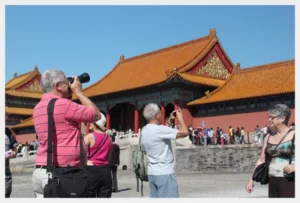
Situated at the heart of Beijing, the Forbidden City is a massive palace complex that served as the imperial palace for the Ming and Qing dynasties. It is renowned for its grandeur, architectural features, and historical significance. The Palace Museum is now located within the Forbidden City.
Exploring the Forbidden City allows visitors to immerse themselves in the monumental legacy of China’s imperial past, appreciate its architectural splendor, and gain a deeper understanding of the country’s rich history and culture.
Temple of Heaven
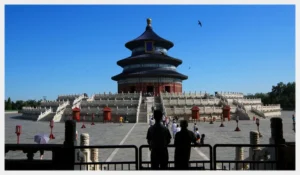
Built in the early 15th century, the Temple of Heaven is a masterpiece of traditional Chinese architecture. It served as a religious and ceremonial site for emperors to pray for good harvests. Its unique circular shape and intricate details make it a must-visit landmark.
The Temple of Heaven stands as a testament to China’s rich cultural heritage and the importance placed on the relationship between humans and the divine. Its architectural beauty, serene surroundings, and historical significance make it a captivating destination for both locals and tourists in Beijing.
Tiananmen Square
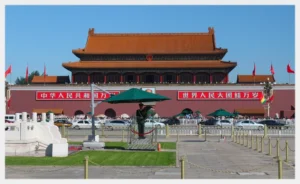
At the center of Beijing, Tiananmen Square is one of the largest public squares in the world. It has historical and political significance and is surrounded by important government buildings such as the Great Hall of the People and the National Museum of China.
Tiananmen Square is located in the heart of Beijing near the Forbidden City. You can easily reach there by taking a taxi or using the Beijing subway system (Tiananmen East or Tiananmen West stations).
If you visit early in the morning, you might be able to witness the daily flag raising ceremony at sunrise in front of Tiananmen Gate. It is a ceremonial event that attracts a large crowd, so plan to arrive early for a good spot.
The Summer Palace
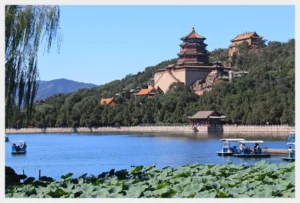
Located northwest of Beijing, the Summer Palace is a vast imperial garden complex and a UNESCO World Heritage Site. It features beautiful gardens, pavilions, and a long corridor by the lake, showcasing traditional Chinese architecture and royal aesthetics.
The Summer Palace is not only a masterpiece of imperial garden design but also a reflection of Chinese history and culture. It offers a serene and enchanting escape from the bustling city, allowing visitors to appreciate the harmonious blend of nature and human creativity.
CCTV Headquarters
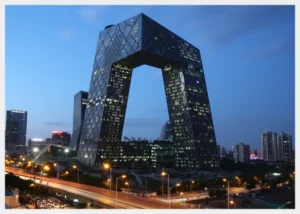
The CCTV Headquarters, also known as the “Big Pants” due to its unique shape, stands out as a modern architectural icon in Beijing. It is the headquarters of China Central Television and has become a prominent symbol of the city’s skyline.
The CCTV Headquarters was designed by the Dutch architectural firm OMA, led by architect Rem Koolhaas. The design is a striking example of contemporary architecture and features an unconventional form often referred to as “Big Pants” or “Giant Underwear” due to its unique shape. The building consists of two leaning towers joined together at the top and bottom, forming a continuous loop.
Construction: Construction of the CCTV Headquarters began in 2004 and was completed in 2012, just in time for the 2008 Beijing Olympics. The building’s unconventional shape presented complex engineering challenges, making it a significant feat of architectural engineering and construction.
National Aquatics Center (Water Cube)

Constructed for the 2008 Summer Olympics, the National Aquatics Center is an architectural marvel. Its distinctive bubble-like structure and blue exterior represent the cube’s design, attracting visitors with its intriguing appearance.
The Water Cube, officially known as the Beijing National Aquatics Center, was designed by a consortium of Chinese and international architects, including PTW Architects from Australia. Its innovative design was inspired by soap bubbles.
Beijing National Stadium (Bird’s Nest)
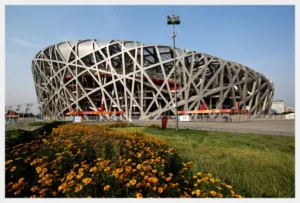
Designed for the 2008 Olympics, the Beijing National Stadium, or the Bird’s Nest, is an impressive steel structure. Its intricate lattice design resembles a twisting nest, showcasing innovative architectural engineering.
The Birds Nest served as the main stadium for the 2008 Beijing Olympics, hosting the opening and closing ceremonies, as well as the track and field events. Since then, it has been used for various sporting, cultural, and entertainment events, including concerts and soccer matches.
National Centre for the Performing Arts (The Egg)

Known as “The Egg,” the National Centre for the Performing Arts is a modern architectural masterpiece. Its spherical exterior, made of glass and titanium, houses multiple performance venues, making it a cultural landmark.
The NCPA was designed by French architect Paul Andreu and features a distinctive, futuristic appearance. Its iconic titanium and glass dome-shaped exterior resembles a large egg or bubble, hence its nickname “The Egg.” The design merges modern aesthetics with traditional Chinese architectural elements.
Location: The NCPA is located in the heart of Beijing, near Tiananmen Square and the Great Hall of the People, surrounded by picturesque water bodies. Its strategic location makes it easily accessible to both locals and tourists.
The China Zun (CITIC Tower)
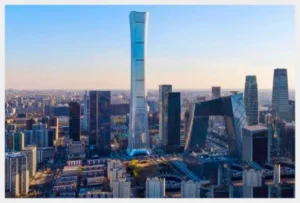
The China Zun, also known as the CITIC Tower, is a magnificent skyscraper located in Beijing, China. Here is some information about the China Zun:
Design and Architecture: Designed by architectural firm Kohn Pedersen Fox, the China Zun is an architectural marvel with a striking design that resembles an ancient Chinese ceremonial vessel called a “zun.” Its unique shape and size make it an iconic addition to Beijing’s skyline.
Height and Size: Standing at a height of 528 meters (1,732 feet), the China Zun is the tallest building in Beijing and one of China’s tallest skyscrapers. It consists of 109 floors, offering a vast amount of office space and other amenities.
Landmark Status: The China Zun has become a significant landmark in Beijing, representing the city’s modernity and economic growth. Its distinctive design and towering presence make it easily recognizable and a popular subject for photographers and visitors.
These are just some of the iconic buildings in Beijing that reflect the city’s historical, cultural, and architectural diversity. Exploring these landmarks provides insights into China’s rich heritage and showcases the country’s architectural achievements.
If you have any questions or queries, then please feel free to drop us a line.

